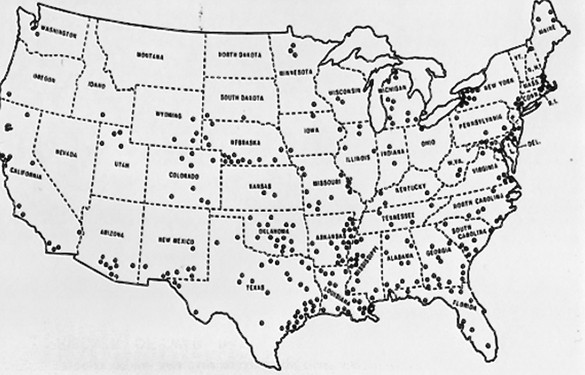
Distribution of the major POW camps across the United States as of June 1944. Courtesy/U.S. Army
By Sharon Snyder
Los Alamos Historical Society
After writing an article recently about a World War II prisoner of war (POW) camp in Kansas, I received several comments and questions that led me to do a sequel and bring the topic closer to home.
Not long after the United States entered World War II, Britain requested American assistance with the housing prisoners of war. They were running out of resources. Their call for help eventually resulted in more than 425,000 POWs in approximately 400 camps in the United States.
They were transported to the U.S. on troop transports emptied of American soldiers on the other side of the Atlantic. Other Allied nations—Australia, Canada, and France, as well as occupied Germany—were also building camps. England continued to operate 90 camps, and Canada created 40.
The U.S. system of camps consisted of base camps and branch camps, and the locations were selected to put POWs close to work sites, most of which were farming regions.
By the end of the war, New Mexico had seven camps. Camps Roswell and Camp Lordsburg were base camps, and POWs who arrived at those camps could be moved to other smaller camps when needed, particularly during harvest season in agricultural areas.
Camp Albuquerque housed Italian and German POWs for farm labor between 1943 and 1946, and most of those men were transferred from Camp Lordsburg and Camp El Paso, both base camps. The earliest prisoners were Italians who arrived in Albuquerque in October 1943 and were housed in former CCC barracks that had been built in the 1930s in Rio Grande Park, just north of the present Rio Grande Zoo.
These men moved again six months later. In 1944, German POWs were brought in and housed in the same barracks for a short time before the men and their barracks were moved to an 8-acre plot on South 2nd Street. There was a maximum of 171 POWs at that camp, and they worked on farms in the valley between Los Lunas and Corrales, helping with harvests.
Though many POWs aided American agriculture, others were assigned to different projects. The Roswell POW base camp was built for up to 4800 POWs, and most of the men were German and Italians captured during the North African campaign. They worked as construction laborers on local projects such as the placement of concrete and stones to line the Spring River that passes through downtown Roswell. Some 60 miles due north, prisoners helped construct the Fort Sumner Army Airfield.
POWs at Santa Fe had a different situation than those in camps. They were transferred to work at Bruns Army Hospital. In 1944, Bruns was designated a special center for chest diseases, and 750 beds were allotted for tuberculosis patients. The 75 German POWs who were sent to Santa Fe performed maintenance work at the hospital.
Two New Mexico camps are noted for somewhat successful escapes. At Camp Las Cruces, Werner Paul Lueck escaped in November 1945. He was recaptured 1954 in Mexico City. A prisoner from Camp Deming had an even more incredible story. Georg Gartner escaped on Sept. 21, 1945, by crawling under fences and hopping on a passing freight train headed for California.
He finally surrendered in Colorado in 1985, having remained at large for 40 years. He had assumed a new name, improved his English, and obtained a social security card.
He worked at various jobs and married an American woman. After so much time had passed, the U.S. Government simply dropped the case. Gartner told his story in a book titled Georg Gartner—Hitler’s Last Soldier.
Many readers of my previous column on POWs agree that this segment of our history has remained obscure, but they also agree that it is definitely an interesting one.

